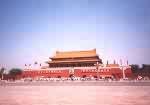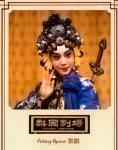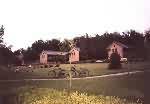- Getting around Lijiang. Dont stay in the Old Towns more than 2 days, there is nothing to do. KRISS Oct 9, 2013 05:46
- 2013 Beijing Temple Fair BENNYLAU Feb 26, 2013 03:29
- Malaysian traveling from KUL - LAX vis Shanghai PVG ZATI_DY Jan 3, 2013 20:15
Revisiting China
- Views: 3520
- |Vote: 0 0
- |Add to Favorites
- |Recommend to Friends
Exploring Beijing as a Tourist and Foreign Investor
My first trip to China occurred nearly ten months earlier. It was the furthest I had ever traveled outside the U.S. This time I was more at ease in preparing for my recent departure. No longer did I need to be reminded of the long flight time, language barriers, or potential visa issues that are well documented in the records of many a foreign student visiting the U.S. I was already an experienced traveler to the Far East having logged some 18,000 miles and nearly a week’s worth of tourism. However, in spite of repeated warnings about the unbearably warm climate during the summer months, I was still unfazed. After all, summer in New York City isn’t without its own degree of stifling humidity. What I soon found was it was no match for walking through the city streets of China in August.
Traveling to China is a wonderful experience in any time of the year. My first journey came in October of 2003, a trip built on both business and pleasure. On both occasions, I had the good fortune to make many new friends, which if you’re a foreign traveler whose only real experience with Chinese culture and tradition comes from a $25.00 dinner tab at the fancy Jade-lined restaurant down the corner of your apartment, they’re an invaluable asset to possess. In considering future travel plans, however, I would first suggest, if you’re on a budget, choose an off-peak time of year, such as October. The summer months in China are not only hot, but they’re the most expensive period, maybe outside of the major holidays, to fly. As I learned quickly, anytime from May through September, round trip flight prices from New York begin at $1,000 and go up about another 30,000 feet from there… you get the idea.
I did plenty of due diligence in seeking out reasonably priced flights during this period, spending nearly as much time on the phone or online as I did vacationing there in the first place. What I found was even though many of these online travel companies do produce fares that are hands-down better than going through traditional travel agents, they all draw from the same well. When you find a reasonable fare, you must know rather quickly what your exact travel dates are otherwise risk losing it. It happened to me, and in a matter of seconds.
If you have more time to spend searching for the best fares, it helps to seek out a travel agent specific to the part of the world you are traveling to. Though I lost my initial fare online, I was lucky enough to land a better one through a Chinese agent saving me some $300 in the process. So there is room to maneuver, however, you must explore all options and have the time to be choosy. I did, and it worked out as well as it could – round trip and one connection from New York to China in August for under a grand is not too bad! Be forewarned though, the trade off to getting these specially priced tickets is there is no flexibility whatsoever – another point I discovered later. If you need to change your travel date or time, or departure time, city, etc. forget it. You must then purchase a whole new ticket. Know the in’s and out’s before you buy. Or… just plan to leave in October; the rates are much lower, nearly half of what they are in the summer, and if you can schedule it, China’s “National Day” Holiday begins in October and lasts an entire week! Not a bad idea.
My first time in China was an educational and entertaining experience, though it was a mixture of research and tourism. For the most part, my time was spent mainly in Wuxi City, a beautiful location in the JiangSu Province that’s at once exotic and cosmopolitan, and within easy reach of nearby major cities as Shanghai or Beijing. This time, my purpose was two-fold; to visit some friends I had made earlier, and to explore investment opportunities in what has become the world's most explosive economic growth story – “capitalism on speed,” is a spin on a thought presented by none other than Bill Gates in an earlier magazine article.
Beijing
I’m always boasting about how great it is to know people in foreign lands so there’s no worry about inter-city travel, lodging, communicating, and so forth. And while this is absolutely true – as meeting with my friend outside of Beijing’s Capital International Airport and knowing I had my own personal tour guide to carry me from place to place was a welcome relief – setting up shop for the next few days at the Beijing Holiday Inn Central Plaza was not the worst thing in the world. The hotel was located in Guanganmen commercial and civic area, adjacent to the new Municipal Government Office Building and within a stone’s throw from Beijing’s Financial Street. I don’t know how far I can throw a stone nowadays but I’d come nowhere close from either of the front or side entrances to the hotel. Not that I had any business to do with the Municipal Government in the first place, but for referential purposes, suffice it to say, the ‘Inn is strategically placed, while only about a 40 minute trek from the airport.
Upon check-in, I had to go back over my travel log to make sure I did in fact make the right plans. A Holiday Inn? With a marble coated lobby, lavish piano lounge, and brass knobbed see-through elevators? Granted it was a new facility, but the only thing reminiscent about this Holiday Inn compared to the one’s I’ve seen at home was the price - $45 per night; or roughly 350 Chinese Yuan. The sad thing is we were on the go so much, I didn’t have enough of a chance to use all of the amenities – fitness center, swimming pool, gaming, salon, etc. I did, however, take advantage of the business center on more than one occasion since I’ve yet to replace my dearly departed laptop. One catch about this though, if you plan to use the internet on a frequent basis, the hotel business centers are far from economical. Get one of the staff members to direct you to the nearest internet café in town – there are plenty of them and at a fraction of the cost. Still in all, it was difficult to get used to being in what equated to a 4-5 star facility where the same price will get you four channels and fleas in the states, and live in the lap of luxury for the better part of a week.
It should be noted, however, that my discounted rate was due to the fact that I booked five days in advance of my arrival. There’s the trick. The price is still cheap by U.S. standards, and many can run as high as $100 or more depending on brand and location, still a bargain, but it’s best to book online, and join one of their card carrying clubs while you’re at it. You can pile up membership points in no time at those rates and be on your way to some free stays for next time.
One thing you notice traveling through Beijing, and something I neglected to notice in my first trek to China, was it’s maddeningly crowded. Coming from New York City, I’m not often fazed by such things as hot weather or crowded streets. If I arrived from, say, somewhere in the Adirondacks, however, the trauma might have been enough to replant me on the next plane home. Beijing, China’s capitol, is a huge city and second to only to Shanghai in total population. It is a beautiful metropolis where modern marvels and ancient wonders sit side-by-side. Just northwest of Beijing proper is a section of China’s massive Great Wall. Dating from the 7th century BC, the wall emerges over thousands of miles of rolling peaks, offering views of the jagged countryside and a fascinating perspective on China’s heritage. As a tourist, it is essential to visit The Great Wall. As big as it is, it’s seemingly far away from everywhere. It’s like the City of Buffalo in New York. Unless you’re starting from within the city limits, it’s a day-long trip from anywhere else! You haven’t been to Beijing unless you’ve seen The Great Wall, and you’ll be greeted with odd looks of disapproval when a local asks your opinion and… if time allows, make the trip. If not, tell everyone you did and make something up. There’s plenty of detail ploughed into the wall itself, but much less required to spin a story to the contrary.
Inside Beijing, lies the Forbidden City, or as it is known today as The Palace Museum, which, for five centuries was the imperial palace of the Ming and Qing Dynasties. It features some 10,000 (though I’ve seen it listed at 8,707) elaborate rooms containing priceless furniture, decorative screens, paintings and statues, as well as centuries-old garden areas with exquisite charm. Across the rather intimidating width of Changan Street, is the gate leading to Tiananmen Square, an expansive area wherein imperial edicts were once read to the public. Renmin Yingxiong Jinianbei, a 125-foot granite column erected in 1958 to honor the “People’s Heroes,” stands in the middle of the square, as does the hall where the body of Chairman Mao Tse-tung lies. In 1949, Communist Party Chairman Mao raised the first flag of the People's Republic of China during a ceremony in Beijing. As China’s most powerful and influential ruler for 25 years, his portrait was hung on Tiananmen Gate where his eyes seem to follow you in either direction… "Long Live The People's Republic of China."
On the south end of the square is the Museum of Chinese History, which houses priceless collections of Chinese art and artifacts, from Tang Dynasty (AD 618-907) tomb relics and Zhou Dynasty (BC 1050-480) bronze wares to Buddhist statues and artifacts from the communist revolution of the early 20th century.
We took an extensive tour of the Palace Museum, for which a guide map is highly recommended, to navigate this massive expanse of flat asphalt and imperial-styled gardens. What follows is wave after wave of gated squares, lofty towers, and broad halls with sloping roofs; it is a truly remarkable taste of 15th century China within the modern day capital. For reference, The Palace Museum occupies over 720,000 square meters with 9,000 bays of halls and rooms. The construction area amounts to about 150,000 square meters and the surrounding walls are 10 meters high and 3,428 meters long. There is also a moat surrounding the outside walls which measures 52 meters wide and 3,800 meters long. The “city” was essentially designed to be a well-fortified castle... and they’d get little argument from me. Most enemies would die of exhaustion just traversing the many steps to and from each successive building, mid-summer or otherwise.
The City is divided into two parts: the outer and inner courts. The outer was the place where emperors handled court-ly affairs and held various ceremonies; the inner court consisted of a number of Halls where the emperor lived and handled day-to-day affairs. Many of the buildings within The Forbidden City were under renovation during our visit, but overall, it has been well preserved and is considered the most magnificent ancient architectural complex in China, and the biggest standing complex of palaces in the world. It was truly awe-inspiring to a momentary step out of time and take in all of the rich magnificence of this period, and to then look out beyond The Forbidden City and see the modern day high-rises and bustling streets.
Beijing also offers visitors plenty of nightlife. Though much of mine was spent inside the elegant Hotel lounge sipping drinks and catching parts of the Olympic Games, to be seen everywhere there was a television. English was spoken there, but rarely, and often only by the European tourists. Some of the popular choices for evening entertainment included theatrical events such as the acclaimed Peking Opera, known as the “quintessence of Chinese culture,” as performed in the Liyuan Theatre where they allow you to visit the make up room and take a group photo with the performers themselves. For those equally as adventurous, and potentially more vivacious among us, there is The Legend of Kung Fu, which takes place every evening at 7:30 in the Red Theatre, and follows the story of a little boy and his ascension into manhood through the practice of Kung Fu and Zen techniques. The show features real Kung Fu, modern dance, acrobatics, and some magical special effects that have to be seen to be believed.
Everyone I came in contact with in Beijing recommended the capital city as the sensible place to pour investment funds. While I was not there long enough to view any significant investment opportunities first hand, I did come away with a better understanding about real estate investing. Initial views of China and foreign investment are quite grim, and rightfully so. This is, after all, a nation in great transition, and though gradual change is taking place, it is an old Communist guard at the helm that is attempting to overhaul a long standing tradition in the face of youthful exuberance, and uncertainty. Nonetheless, given China’s booming economy and their acceptance into the WTO, this has to happen, one way or another.
I did not leave there convinced that investing in Beijing made perfect sense; it’s expensive, but my feeling is that it will be one to watch as we move closer toward the 2008 Olympic Games and infrastructural renovations and development begin to take shape. In fact the city will get a major overhaul in preparation for the games. There will be massive amounts of monies, both foreign and domestic, flowing through there in preparation for the historic event. When the games arrive there in another four years, they will be hugely popular and there will not be any empty seats.
I have some reservations about investing in property there, even as I write this, though I am keeping an eye open in the near future. Being one of mainland China’s biggest cities, Beijing is amassed with overcrowding and from my perception, overzealousness in building. There can be seen many a crane flailing atop unfinished buildings, a potential reflection of poorly managed projects from little-known developers. There is talk of a real estate bubble as the government tries to weed through inflationary issues as they stand in as the evil twin counterbalance of the overall budding progress with China’s soaring growth rate.
As things stand now, property investing remains strong, while interest rates remain inviting, but that is not likely to last too long as the government must continue trying to tighten the collective belt of free spenders living large off easily attainable bank loans and try to maneuver the economy through to the soft landing frequently spoken of, while avoiding the hard one often feared. In terms of foreign investing, it has gotten easier in terms of banking flexibility, and more importantly, governmental stability and the transparency to allow the individual investor some degree of security to do business in a major city like Beijing. The government, offering more federal than state-dependent support, continues to step forward to encourage foreign investment, which in many cases still sits the sidelines with a “wait and see” approach; however, finding good value may be the real catch here.







 Copyright © 1998-2025 All rights reserved.
Copyright © 1998-2025 All rights reserved.